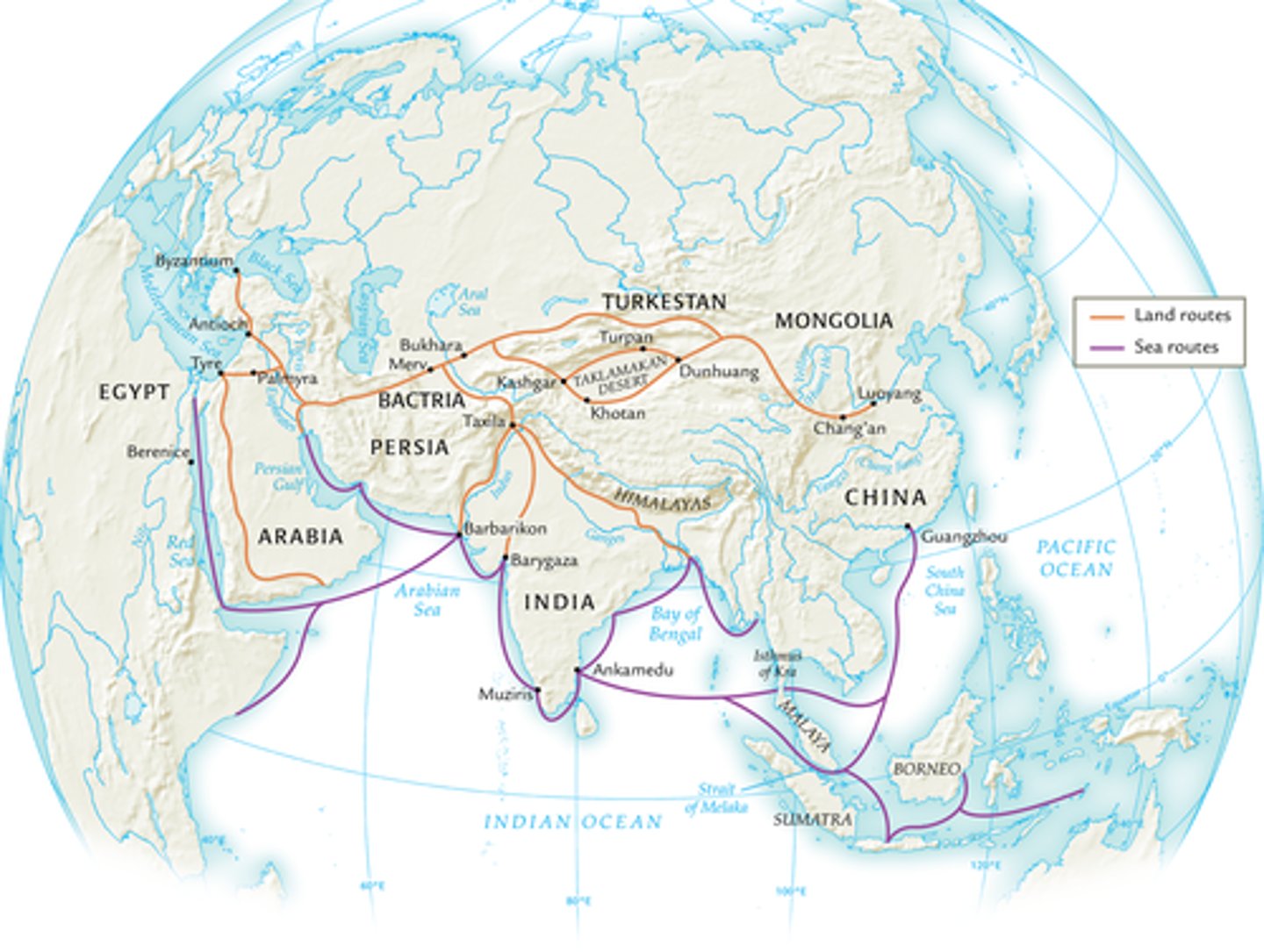HN World History Classical Period Test
1/103
There's no tags or description
Looks like no tags are added yet.
Name | Mastery | Learn | Test | Matching | Spaced |
|---|
No study sessions yet.
104 Terms
Persian Empire
A major empire that expanded in much of Southwest Asia (from Egypt to the Hindu Kush).
Achaemenid Empire (558-330 BCE) -> Seleucid Empire (323-83 BCE) -> Parthian Empire (247 BCE - 224 CE) -> Sassanid Empire (224-651 CE)
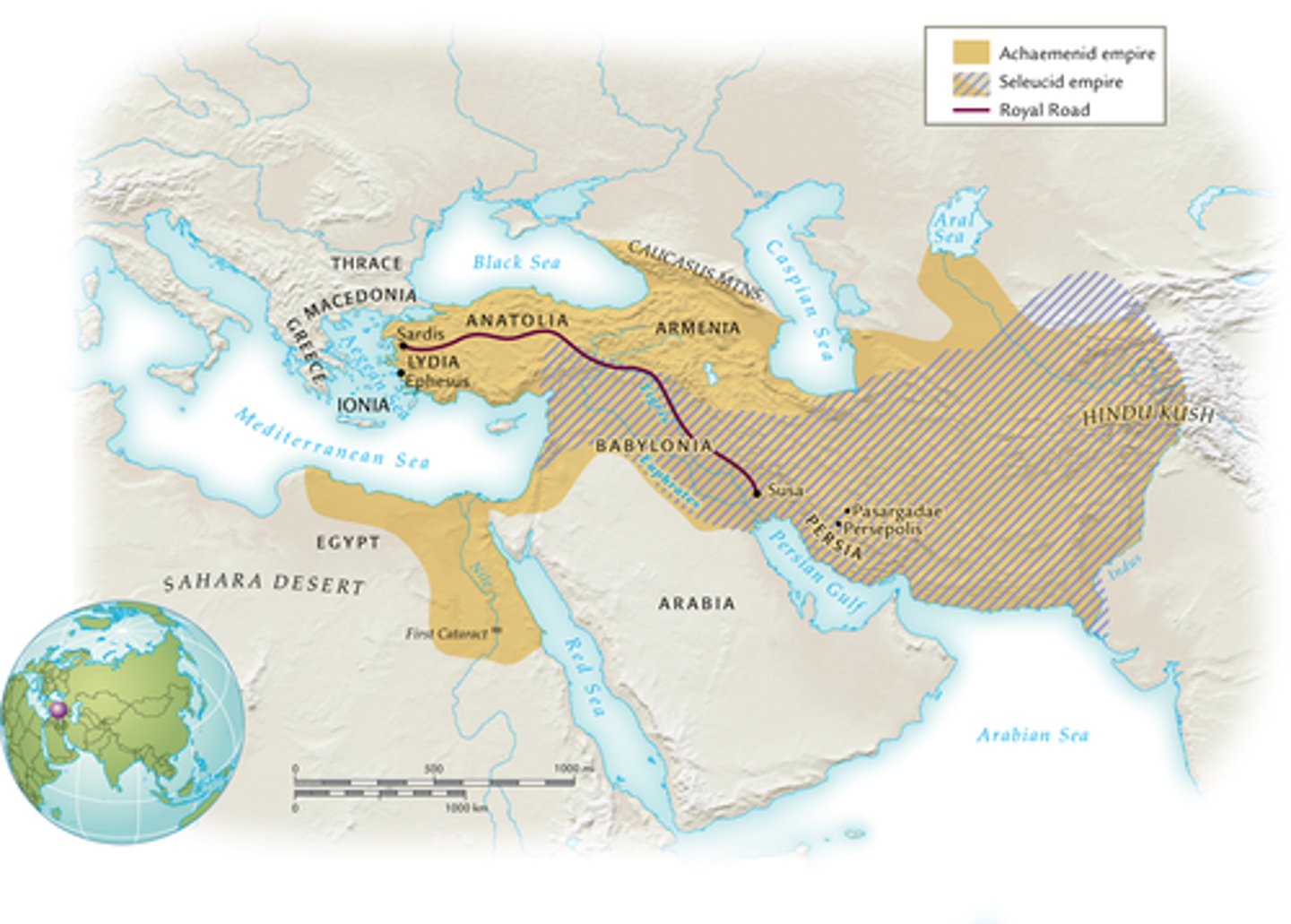
Achaemenid Empire
Starts with Cyrus the Great going through the Persian Wars and doesn't end until Alexander the Great (Greece) conquers Persia. Cyrus conquered many regions, eventually holding an empire that stretched from India to the borders of Egypt. After Cyrus, his son Cambyses conquered Egypt. Then Darius continued to expand the empire while also uniting the different ethnic groups under Achaemenid control. The Achaemenids were very tolerant of different cultures (even between monotheistic vs polytheistic).
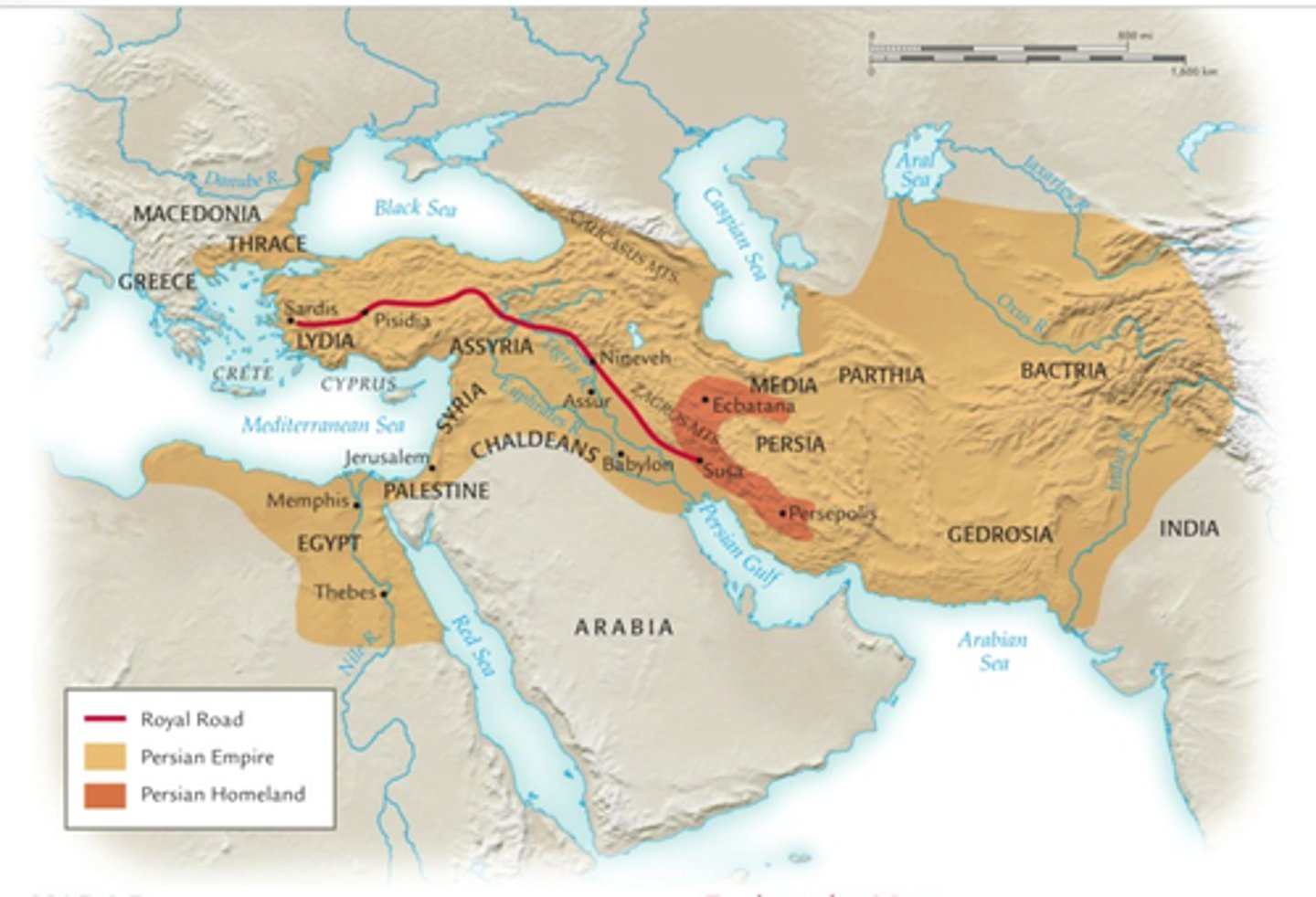
Satraps
Officials appointed by the King who rule in the name of Persia through the empire. The Persian government had spies who would check on the satraps to make sure they were doing their job properly.
Royal Road
Went across the length of the Persian Empire and could move troops and trade quickly + efficiently.
Qanats
Underground irrigation canals that provided a reliable source of water throughout the empire.
Persepolis
The capital of the Achaemenid Empire. It was made to reflect the nomadic origins of the Persians with lofty ceilings and supportive poles like tents. Eventually burned down by Alexander the Great.
Zoroastrianism
A monotheistic religion followed in the Persian Empire. It was about the freedom to choose right or wrong & taking individual responsibility for one's actions. It valued the duality between good and evil with a good god that people worshipped and a bad god (like Satan) that people didn't worship. It had an afterlife based on reward/punishment (seen in later monotheistic religions) and ideas of heaven + hell.
Polis
A Greek city-state. They were organized with an urban center & surrounding countryside. They usually had outer walls for protection, central market places (agoras), and temples/government buildings on top of an hill (acropolis).
Athens
A Greek city-state. Governed by a monarchy from 750-550 BCE, then shifted to an oligarchy over time. But after that a couple of factors (phalanx, acropolis, agora, and Solon) led to it becoming a democracy.
Democracy
A political system in which the supreme power lies in a body of citizens who can elect people to represent them.
Persian War
Greek cities on the Ionian coast felt oppressed by Persian rulers so the Athenians sent military aid to the Ionians. That angered Darius and he started a campaign against Greece. This led to a few battles (like Marathon) that the Greeks won. A decade later, Xerxes tried to avenge Persian losses and the battles continued. After continuous skirmishes for a while, the Greeks won.
Peloponnesian War
Conflict between Athens and Sparta that weakened the Greek poleis. Athens committed war atrocities and lost its reputation as the moral and intellectual leader of the Greek people, turning into an arrogant, insensitive, imperialist power. Sparta beat Athens but other poleis were jealous once again, leading to conflict between Sparta, Thebes, Corinth, and other poleis.
Philosophy
The study of the fundamental nature of knowledge, reality, and existence, especially when considered as an academic discipline.
Alexander the Great
He was the son of Phillip of Macedon (advanced into northern Greece, annexing the poleis weakened by the Peloponnesian War). Phillip was assassinated before he could carry out his invasion of the Persian Empire, so his son - Alexander - conquered the Persian Empire + surrounding areas, extending the empire all the way from Egypt to Northern India.
Alexandria
Capital city in Egypt founded by Alexander the Great, center of commerce and Hellenistic civilization. It had an enormous harbor which allowed it to become the most important port in the Mediterranean. It was a melting pot of Greeks, Macedonians, Egyptians, Phoenicians, Jews, Arabs, and Babylonians. Home to the famous Alexandrian Museum and the Alexandrian Library.
Hellenism
The diffusion of Greek culture throughout the Mediterranean world after the conquest of Alexander the Great.
Hellenistic civilization was a blend of Greek, Persian, Egyptian, and Indian culture. Started by Alexander the Great. It was comprised of the territories Alexander the Great's empire split into. They helped integrate economics and societies of distant regions, leading to cultural diffusion of beliefs, values, religions, and goods over great distances.
Warring States Period
Occurred after the Zhou and Qin dynasties. The Zhou dynasty became too decentralized and they were facing a lot of rebellion along the Yellow River Valley. Different factions were fighting for control of the empire before the Qin Dynasty became victorious.
Daoism & Confucianism were around before this time, but their ideas started to be more appealing during these troubled times. They turned to these philosophies along with Legalism to help guide their actions during this time period.
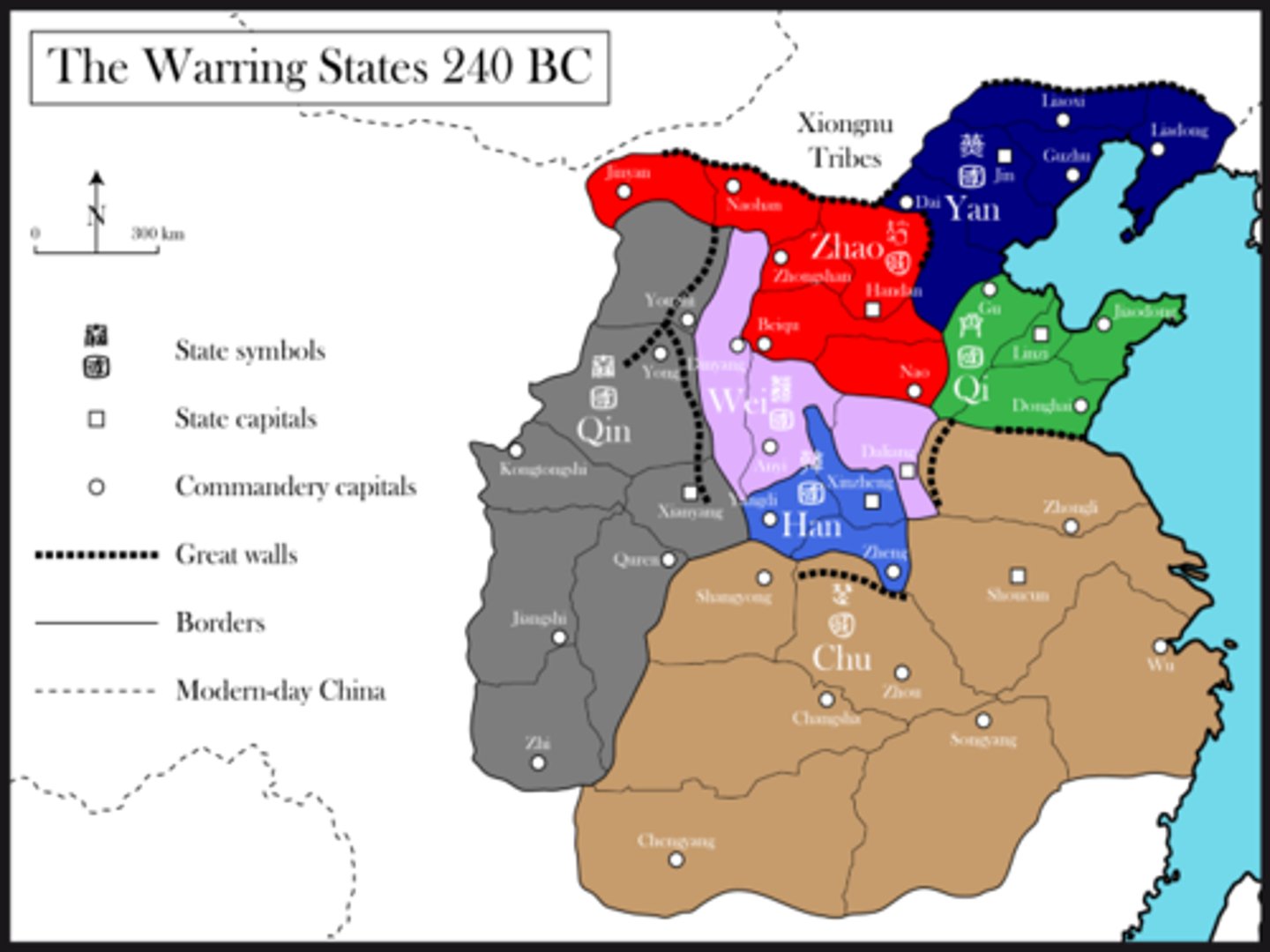
Qin Dynasty
First empire in China. Existed from 221-206 BCE after emerging victorious from the Warring States Period. Set the standard for empires that followed it. Practiced Legalism. Fell because subjects weren't happy with the harsh rule and believed Qin Shi Huangdi lost the Mandate of Heaven.
Qin Shi Huangdi
First Chinese Emperor. He centralized power, started building the Great Wall, created a currency, simplified the written language, and his burial tomb established the grandeur of being a Chinese emperor.
Han Dynasty
Imperial dynasty that ruled China from 206 BCE - 9 CE. Followed a combination of Legalism and Confucianism (rigid patriarchy + filial piety). Fought against the Xiongnu nomads a lot (never won). Agriculture was super important because there was a population boom and people needed to be fed. They innovated iron metallurgy, silk textiles, and paper. Had taxes, land distribution was unequal (rich got richer -> poor got poorer). Fell because of peasant rebellions/internal conflicts and became large regional kingdoms again.
Liu Bang
Set the stage for the Han Dynasty. He walked a middle path between the excesses of previous rulers by allowing imperial family members to keep large landholdings and dividing empire up into sections run by loyal administrators.
Han Wudi
Also known as the "Martial Emperor" because of his vigorous and active leadership. He focused on administrative centralization (imperial officers, transportation, taxation, monopolies, and Confucian educational system) and imperial expansion (invaded Vietnam and Korea, establishing Han cultural influence).
Daoism
A belief system founded in China by Lao Tzu.
Essential Belief: "life must be lived simply, close to nature, and with the intention of letting life come to you rather than you actively going after it". There is no "good" or "bad" but there is a balance between them.
Lao Tzu
The founder of Daoism. We don't know much about him. He is known as "The Master" and may have been a teacher of Confucius.
Wuwei
A belief of Daoism. Means "Not do" or "inaction".
Tao Te Ching
A series of short poems that outline the basic tenets of Daoism.
Confucius
A Chinese philosopher known also as Confucius and created Confucianism, one of the most influential philosophies in Chinese history.
Confucian Education
A Han Dynasty education system that rained young men for government work and established Confucian thought in the empire. Confucianism was used mainly because it was the most fleshed out/developed belief system that aligned with the Han Dynasty's goals at the time.
The Analects
The principal text of Confucianism. It's essentially a series of conversations between Confucius and his students where he explains how to create a benevolent and well-ordered society.
Ren
A Confucianism ideal. Behaving the way a person should always behave, with benevolence, kindness, propriety, and correct behaviors.
Li
A Confucianism ideal. Rituals & the proper practicing of them. This is how to greet people, behave at a dinner, mourn for a parent, and more.
Filial Piety
A Confucianism ideal. Love of family. They believed that if people had proper respect for family members then those habits would spread to society all the way up to leaders.
Legalism
A Chinese belief system founded by Han Feizi.
Essential Belief System: People are inherently bad so strict laws must be made to keep people in line. The government must be strong and obeyed by all. They valued citizens that worked in agriculture or the military because arts, education, religion, etc. didn't directly benefit the state.
There was no "ideal" to reach; no "path", "way", or "filial piety". It's a pragmatic view of the world where they saw that punishment was the easiest way to get people to do something.
Confucianism
A belief system founded by Confucius.
Essential Belief: "People are naturally good and that goodness/benevolence can be fostered through rites and relationships."
Buddhism
A peaceful religion based on the teachings of Siddhartha Gautama/Buddha. People who followed it weren't beholden to the Indian Caste System.
Siddhartha Gautama
The founder of Buddhism. He was raised as a Hindu prince but renounced his pampered life when he discovered how other people were suffering. He meditates under a Bodhi tree and becomes the Buddha ("the enlightened one").
His teachings were particularly appealing to lower castes/women because they gave more freedom/alternative to marriage.
Buddha
Means "Enlightened One." He is said to have found a path for overcoming suffering.
4 Noble Truths
The four main ideas of Buddhism.
1. All Life is Suffering
2. Suffering is Caused by Desire
3. If you eliminate desire, then you eliminate suffering.
4. Follow the Eight-Fold Path.
8 Fold Path
Eight steps to end suffering and attain enlightenment according to Buddhist tradition.

Stupas
Buddhist shrine that is shaped like a dome or mound. It usually houses sacred relics associated with the Buddha or other saintly persons. Ashoka spread them around his empire.
Theraveda
The more orthodox branch of Buddhism. Places an emphasis on breaking away from society and living a monastic life. This branch spread out of India to Sri Lanka, Thailand, Cambodia, Vietnam, and Indonesia.
Mahayana
Means "Great Path" or "Great Vehicle". It allows people to achieve salvation through supporting temples/monks rather than living the monastic life themselves. It's the dominant form of Buddhism in China, Japan, and Korea.
Xiongnu
Nomads living on the steppes of Central Asia/Mongolia. They were fierce warriors (excellent horse riders/bowmen) who raided Han villages and trading routes. They are the main reason the Han improved the Great Wall. Han essentially paid the Xiongnu tributes/tried to intermarry to stop the raids (not very successful long-term).
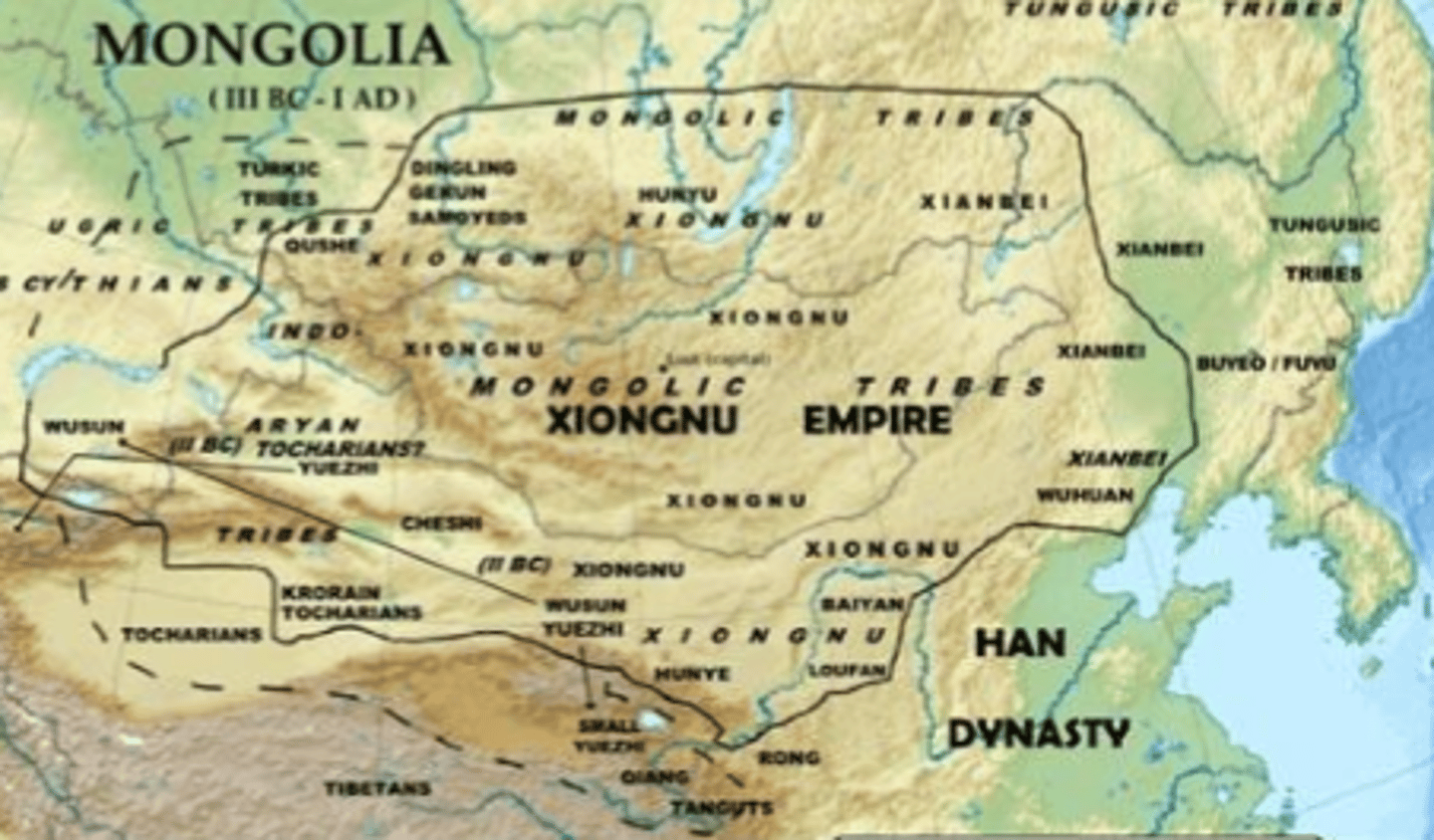
Wang Mang
Ruled China from 9-23 CE. He pledged to break up large estates and redistribute land, winning over the masses. However, he wasn't able to implement this plan very well (landowners fought against him by funding their own armies). He was killed in 23 CE and the Han were back in power.
Hinduism
The oldest world religion (polytheistic) that was influenced and shaped by both Aryans and Dravidians.
Essential Belief: Humans are reincarnated beings whose experiences in this life are shaped by previous lives.
Jainism
A religion practiced in Eastern India that stresses the importance of acting ethically & unselfishly. It teaches meditation, self-denial, and extreme forms of ahimsa.
Ahimsa
The principle of nonviolence toward all living things
Mauryan Dynasty
Dynasty that filled in the power vacuum left by Alexander the Great and conquered most of India (except for Southern tip).
Dynasty fell because of economic meltdown (not enough taxes to support the empire -> currency declines -> empire dissolved).
Chandragupta Maurya
Chandragupta Maurya (NOT CHANDRA GUPTA) combines regional kingdoms into a bureaucratic administration with a centralized government across India. His government reflected values depicted int he Arthashastra (trade, agriculture, international relations, etc; written by Kautalya).
Ashoka
Conquered Kalinga then converted to Buddhism as a way to pay for the violence he caused. He spreads Buddhism through the empire with stupas/monasteries, rock edicts, land grants to Buddhists, and missionaries. He also had a centralized government and efficient treasury (taxes, irrigation, roads, etc).
Stone Pillars/Edicts
Ashoka used rock edicts to spread Buddhism through the Mauryan Empire. They were writing carved into stone pillars throughout the region.
Sanskrit
The most important language of ancient India.
Gupta Dynasty
Chandra Gupta (NOT CHANDRAGUPTA MAURYA) builds the dynasty through alliances (decentralized government). They brought stability back to India and this was known as India's Golden Age because there was a lot of time for creative pursuits & innovation. They pushed health practices and medical techniques like yoga, meditation, plastic surgery. Made advancements in astronomy (earth is a sphere + rotates on an axis) and math (0, calculated pi, modern # system).
Dynasty declined because of invasions by the White Huns (nomads) who fractured them into regional kingdoms.
White Huns
Nomadic invaders from central Asia who weakened the Gupta Dynasty.
Judaism
The monotheistic religion of the Jews.
Essential Belief: They believed in Abraham's Covenant (made with Yahweh; belief that Canaan belonged to the Israelites) and that they were to be God's chosen people.
Patricians
The elite families of Rome (5% of population; citizen) whose power came from political participation and inherited land/wealth. They were wealthy landowners, the leading class (consels, senators, praetors/judges), descendants of "founding fathers", and could veto laws.
Plebians
They were the common folk of Rome (95% of population; citizen). There was a huge range from a rich merchant to a poor laborer, but both were in this class. They had to pay taxes and weren't involved in government.
If they were ambitious, they'd get a Patrician 'Patron' who would help them with loans, legal problems, developing business relationships, etc.
Pater Familias
Means "Father of Family"; Fathers had complete control over their family (patriarchy) so they could decide marriages, occupations, sell family members, or kill them.
Latin
The language of the Romans. Eventually evolved into languages we know today like English, Spanish, French, etc.
Roman Republic
Roman model of government from 509 BCE - 49 BCE. Power was held by the citizens who elect representatives to make laws. These representatives were Senators, who served in the Senate and made decisions for Rome. The Consul were the 2 elected leaders of the Senate (one year term) and the Tribune were elected representatives of the Plebians who could veto Senate decisions.
They followed the Twelve Tables which were the first written laws of Rome and established modern legal concepts like innocent until proven guilty & the right to know your accuser.
Julius Caesar
He made himself "dictator for life" by crossing the Rubicon River and overthrew the Roman Republic. He was eventually stabbed to death by Roman Senators in 44BCE because they were unhappy with him (but they didn't succeed because Augustus/Octavian took over after Caesar anyway).
Augustus
Julius Caesar's nephew (aka Octavian) who became ruler of the Roman Empire ("First Citizen) in 31 BCE.
Roman Empire
Started in 31 BCE when Octavian became "First Citizen". This was the period of time when Roman expansion/colonization was a big thing AND when Rome was ruled by an emperor instead of a democratic form of government like the Republic. The Roman Empire brought the Pax Romana (31 BCE - 180 CE) or "The Roman Peace" which was when Rome was at its height of power and stability.
Christianity
An Abrahamic, monotheistic faith. The Romans persecuted Christinas in early centuries, but Christianity eventually became the official religion of the empire.
Essential Belief: Jesus was the son of God and came to Earth to die for the sins of humanity.
Gospels
Four books in the New Testament (Matthew, Mark, Luke, and John) and describe the life of Jesus. They present a vision where the "meek will inherit the earth" and salvation is possible for everyone, regardless of social class. This directly challenges the Roman Empire's power which is where all the turmoil begins.
Manicheism
A religion based on the teachings of Mani that developed in Persia in the third century CE. It saw the world as a mixture of light and dark. It taught a radical separation between the evil material world and the good world of the spirit.
Constantine
Emperor of Rome who adopted the Christian faith and stopped the persecution of Christians (280-337)
Edict of Milan
Issued by Emperor Constantine and stated that Christianity (among other religions) will be tolerated in the Empire and you can practice what you want with no repercussions.
Nicene Creed
The statement which outlines what you must believe in order to be a Christian (standardized the different branches of Christianity). If you belonged to a Christian cult that doesn't follow this, the Church doesn't recognize you.
Theodosian Code
Makes Christianity the only legally protected religion of the Roman Empire. Anyone not a member of the Catholic Church is considered a "heretic" and may be legally prosecuted by the Roman Empire.
Silk Road
A network of trade routes that linked China with the West and other regions for over 1500 years. It carried goods (silk, gold, spices, etc) and ideas (religion, culture, etc) between different civilizations.
Syncretism
A blending of beliefs and practices from different religions into one faith.
Athens (MAP)
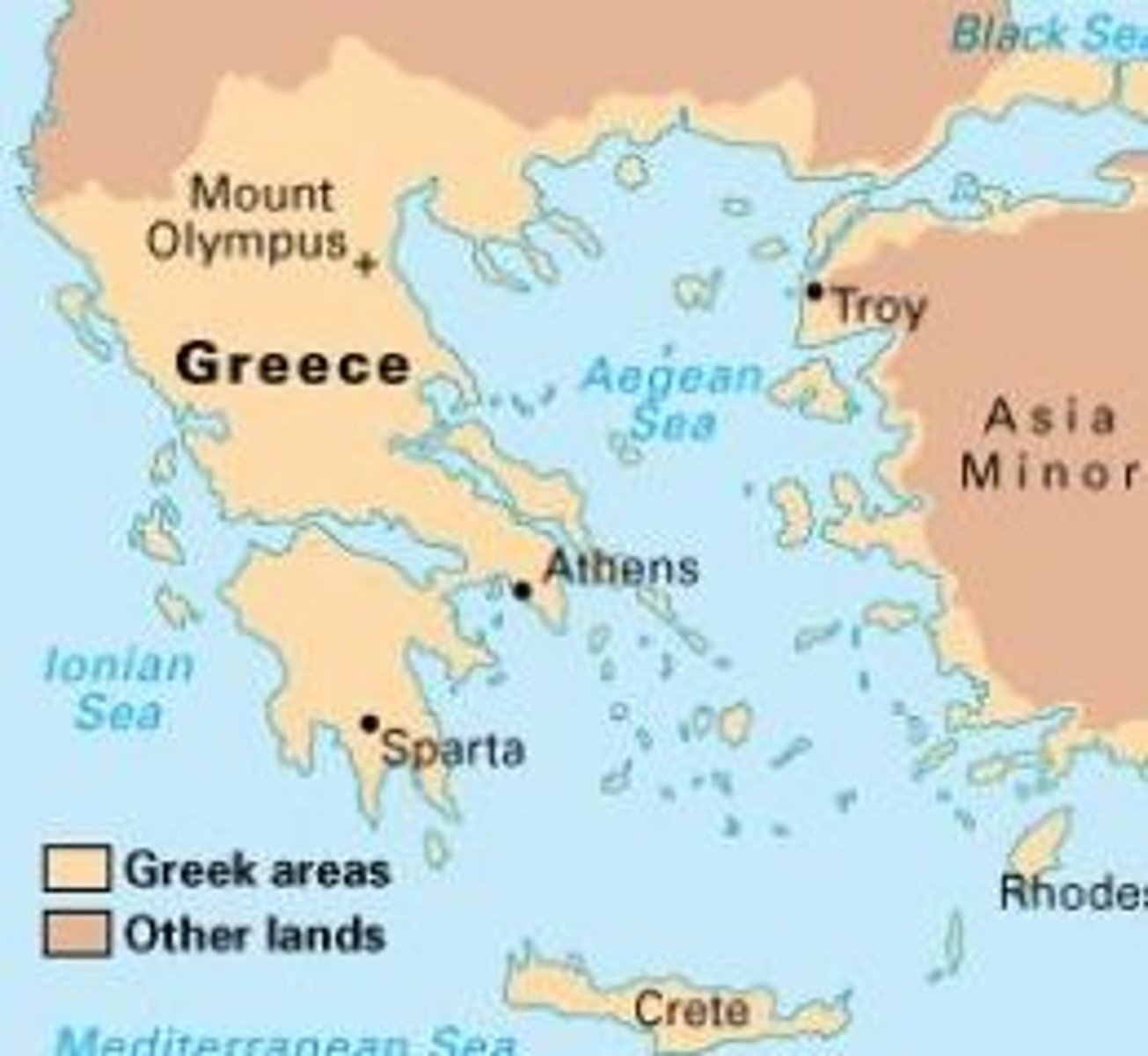
Persepolis (MAP)

Alexandria (MAP)
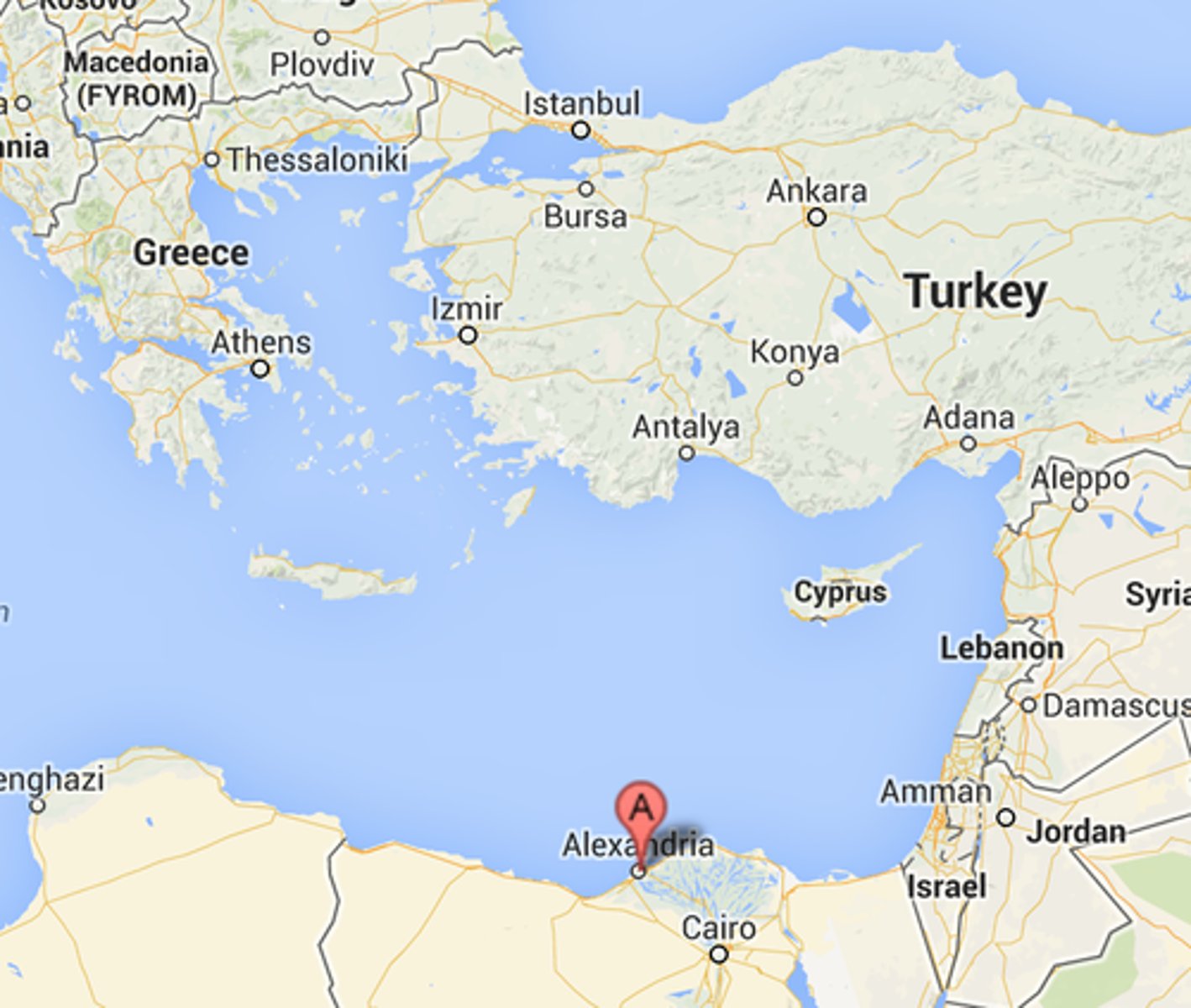
Rome (MAP)
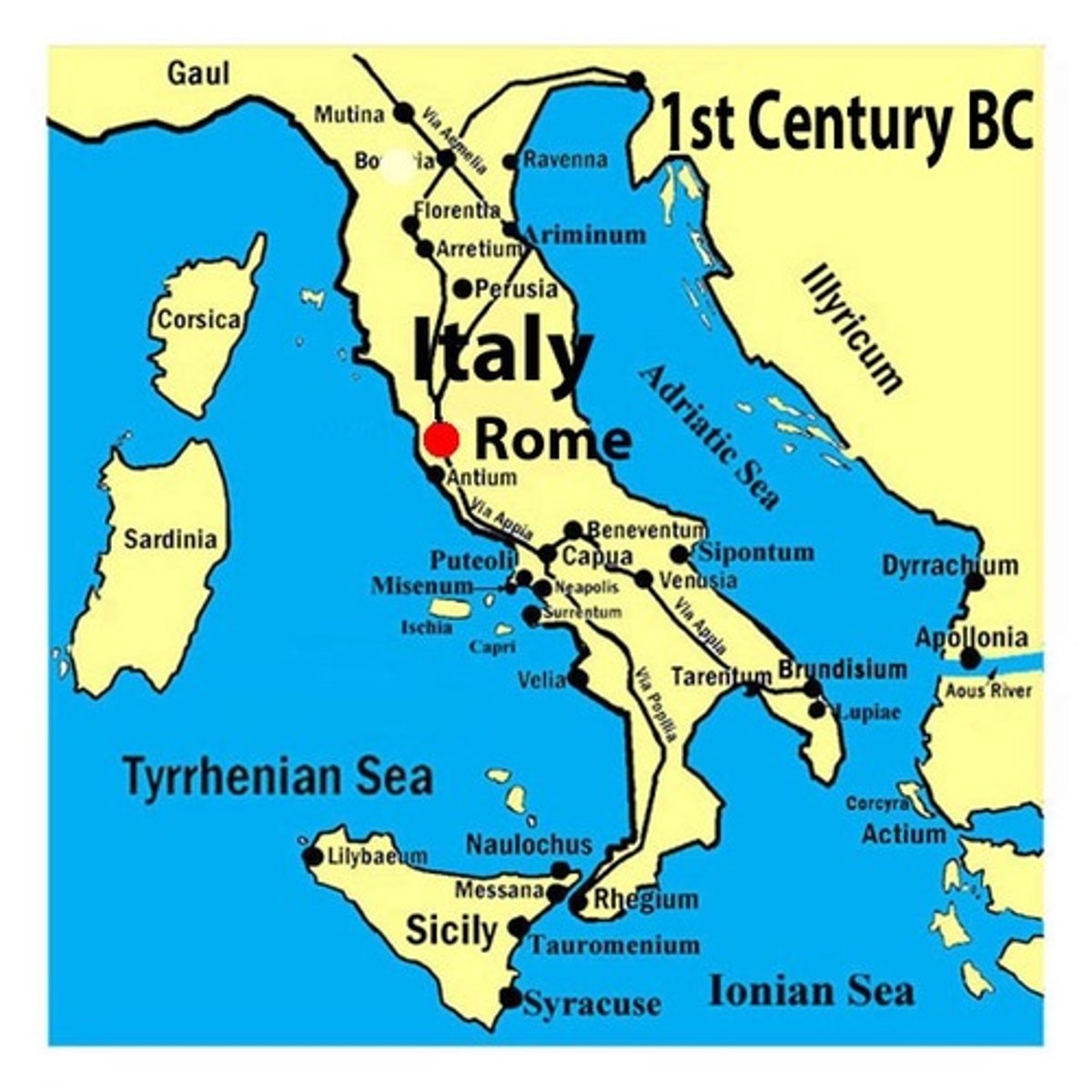
Carthage (MAP)

Judea (MAP)
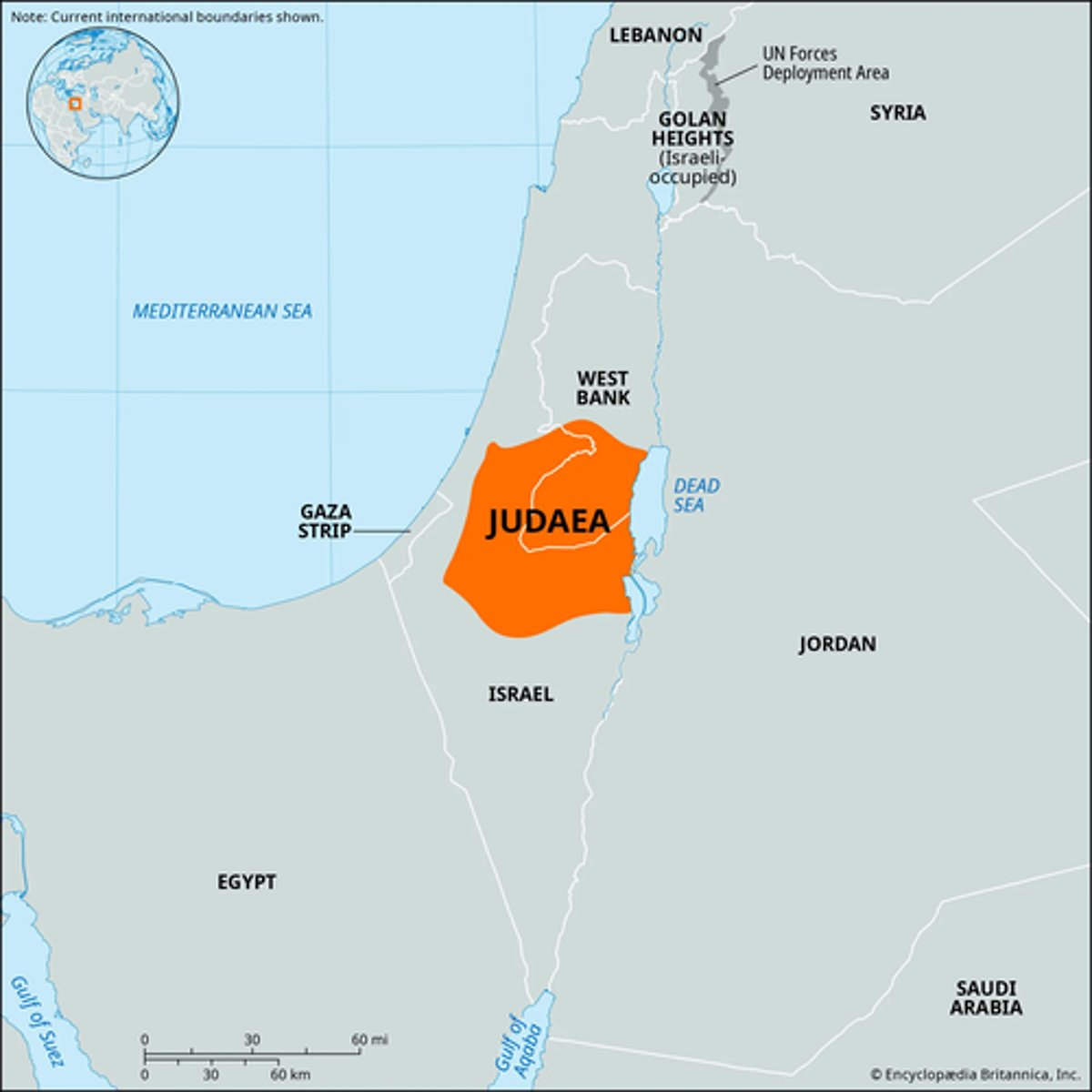
Mediterranean Sea (MAP)
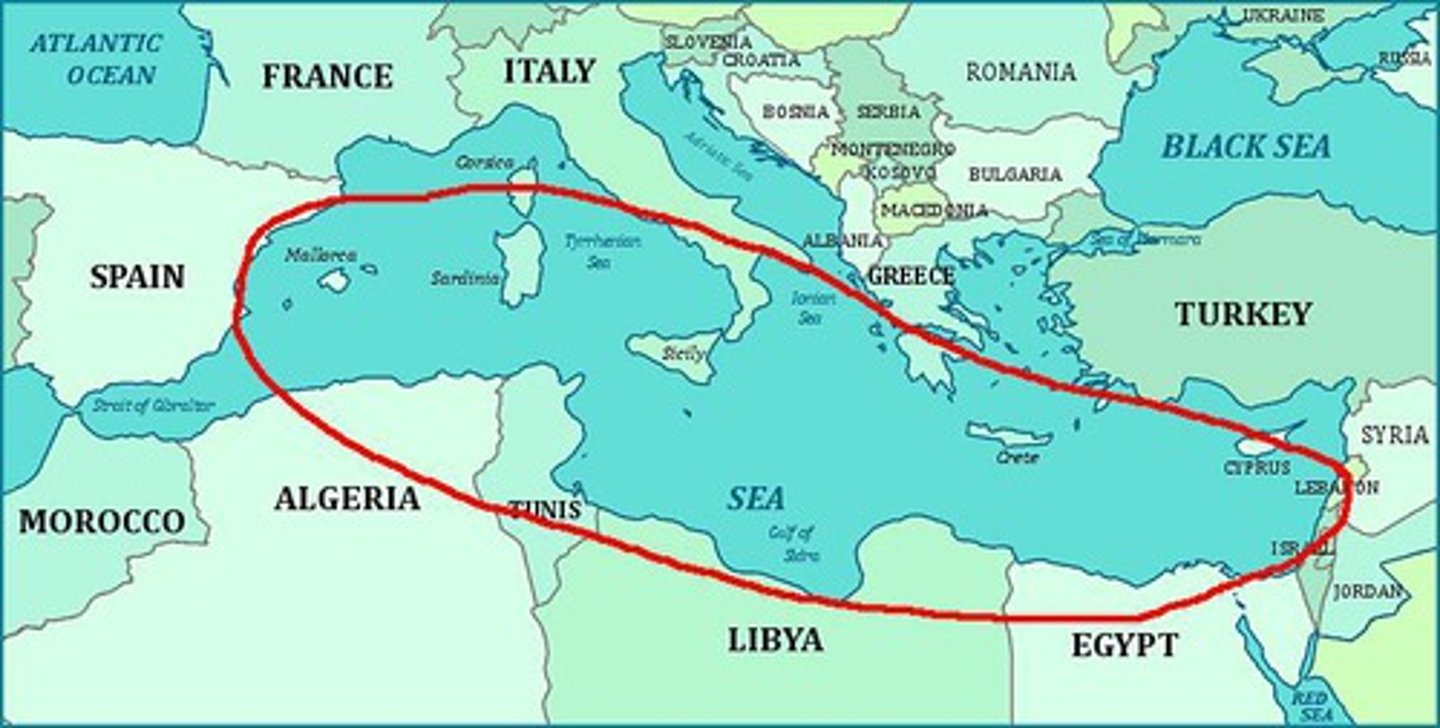
Constantinople (MAP)
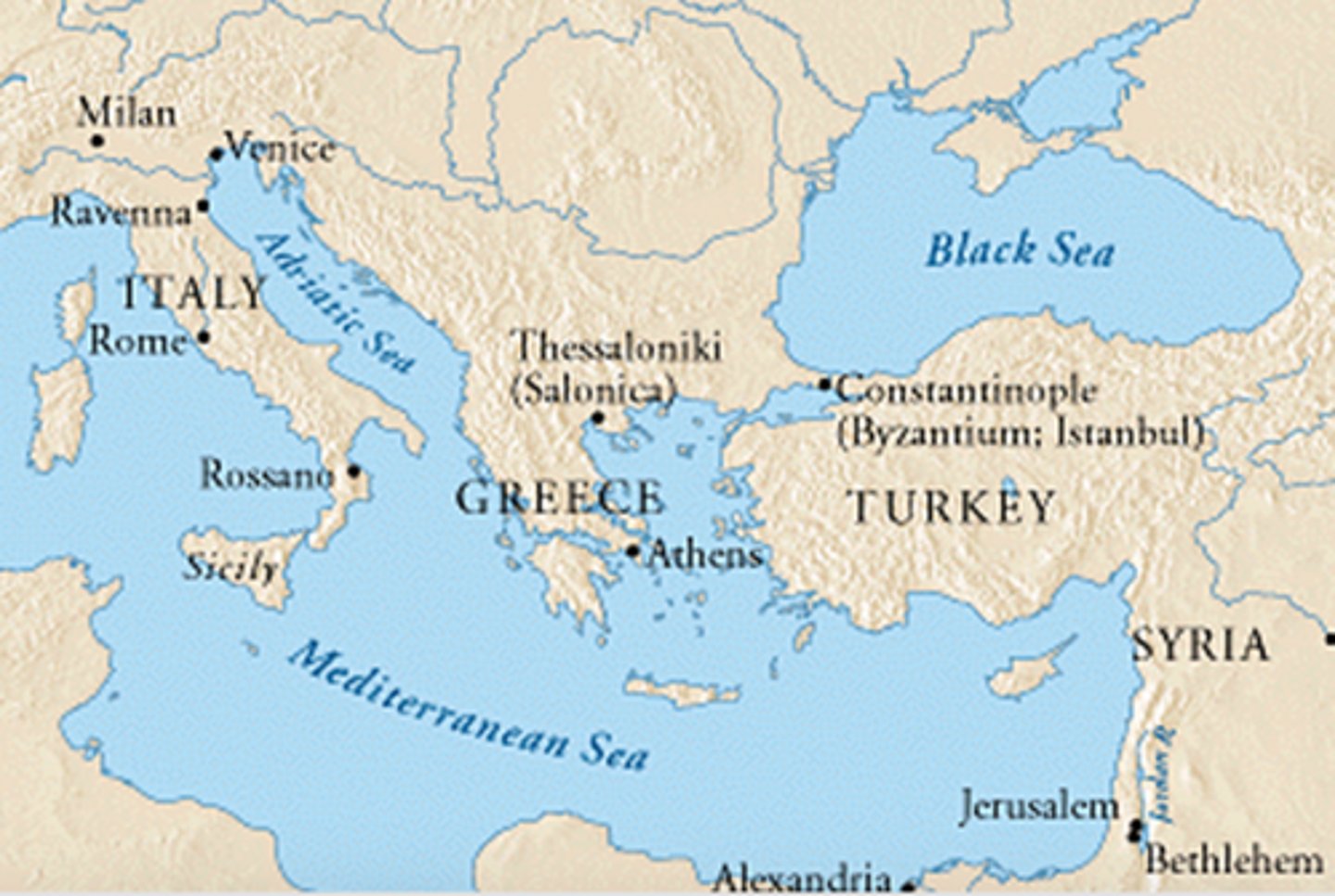
Bosporus Strait (MAP)

Red Sea (MAP)

Indus River (MAP)
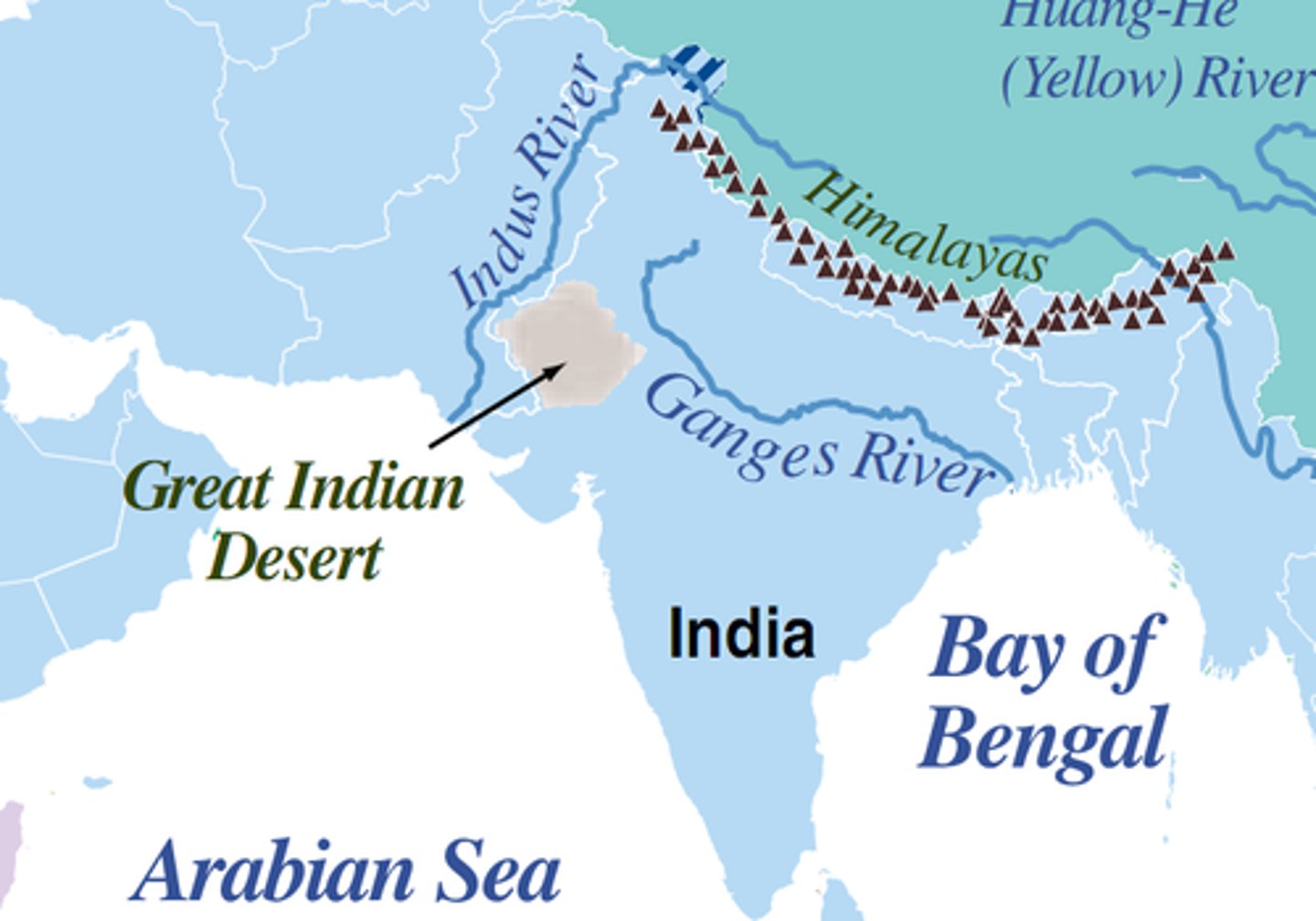
Ganges River (MAP)
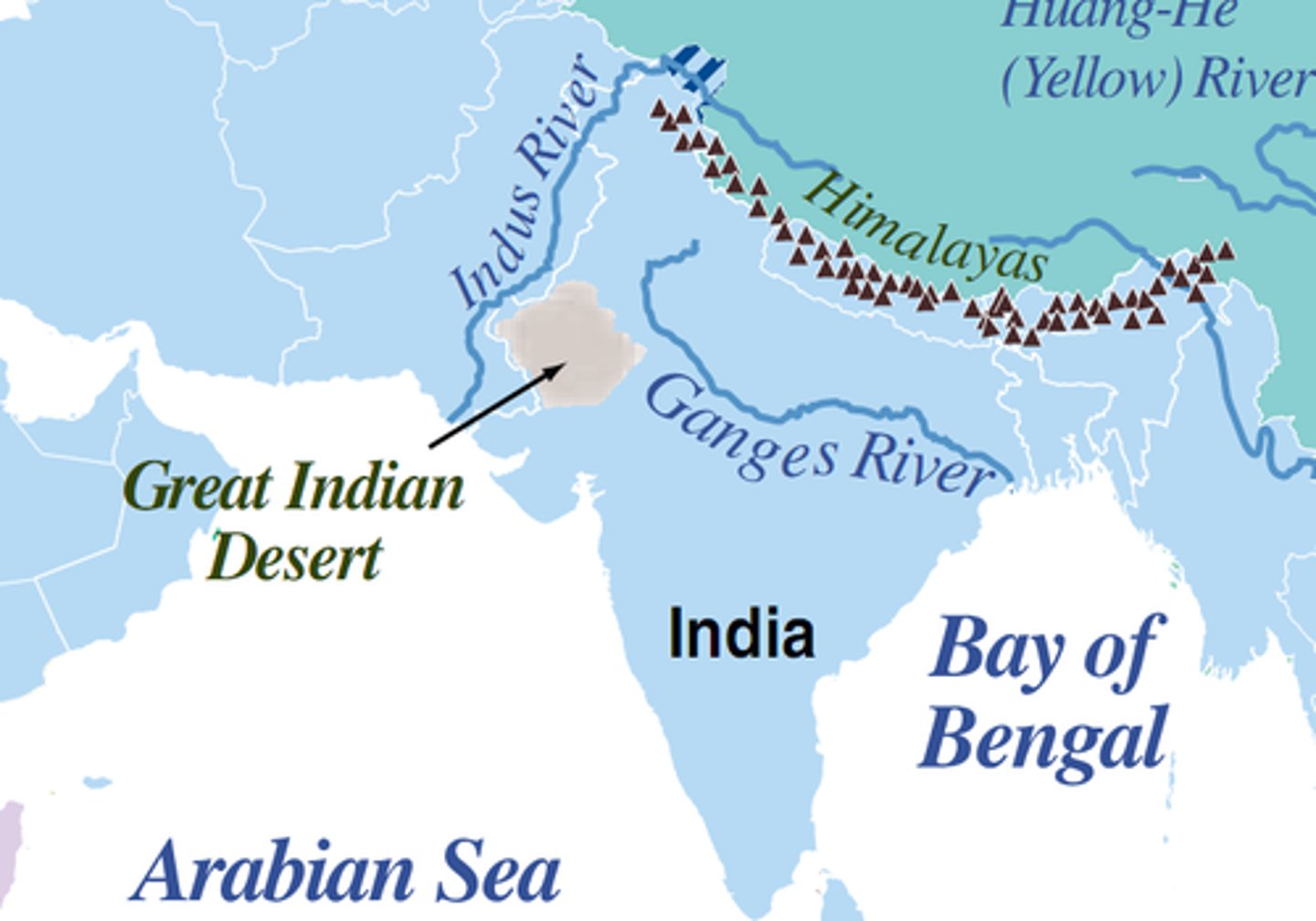
Indian Ocean (MAP)
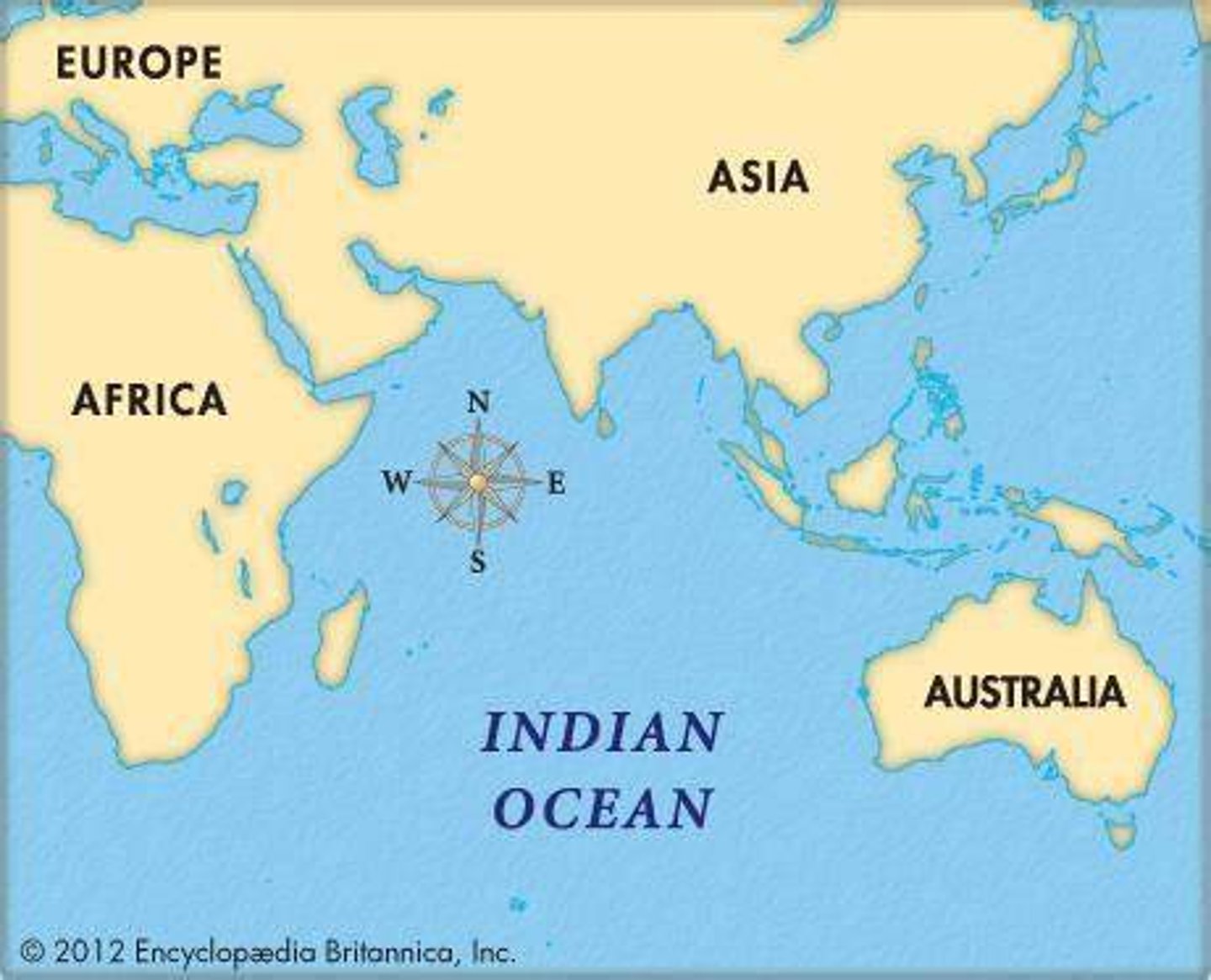
Arabian Sea (MAP)
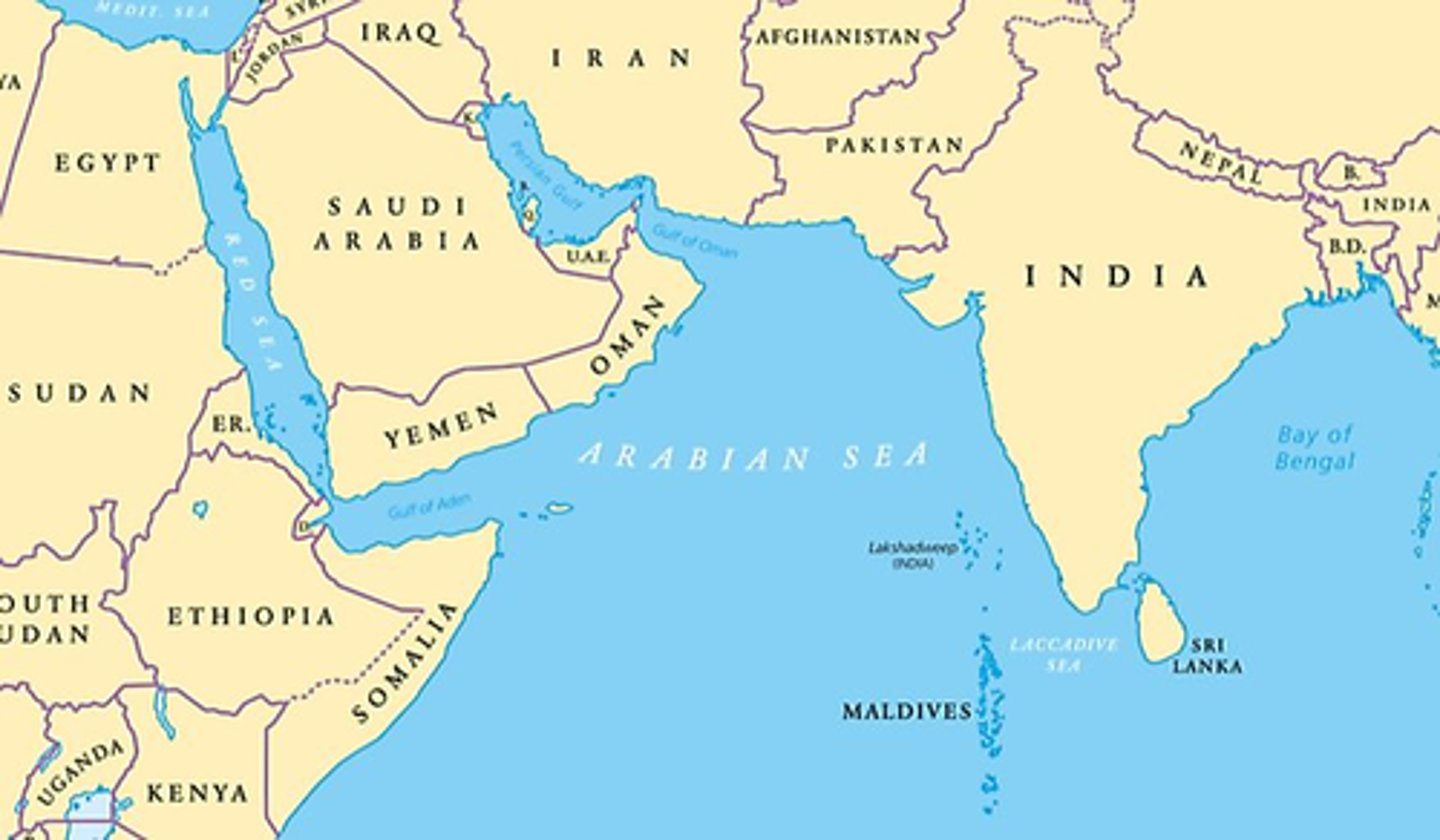
Aegean Sea (MAP)
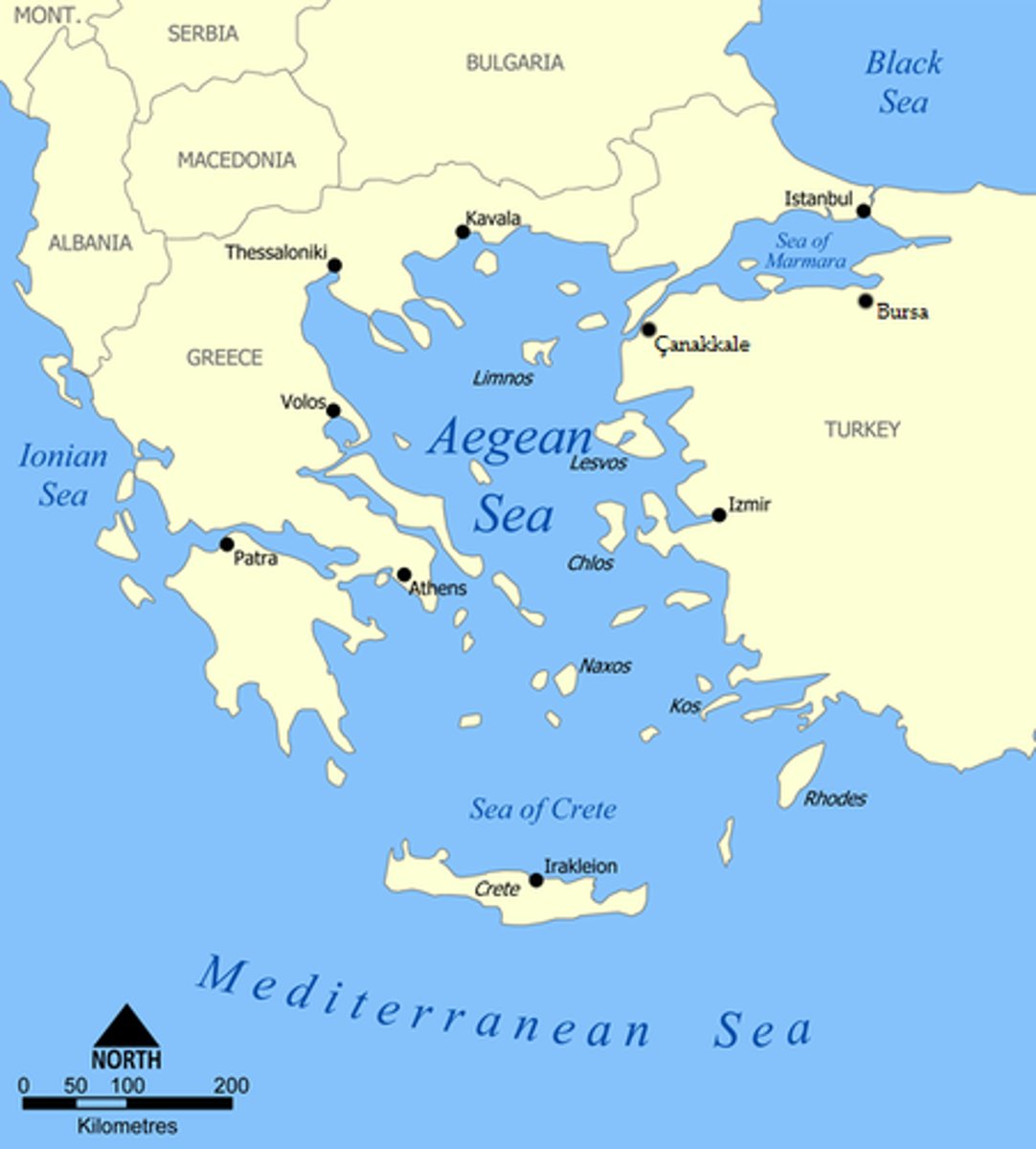
Yellow (Huang He) River (MAP)

Yangtze River (MAP)
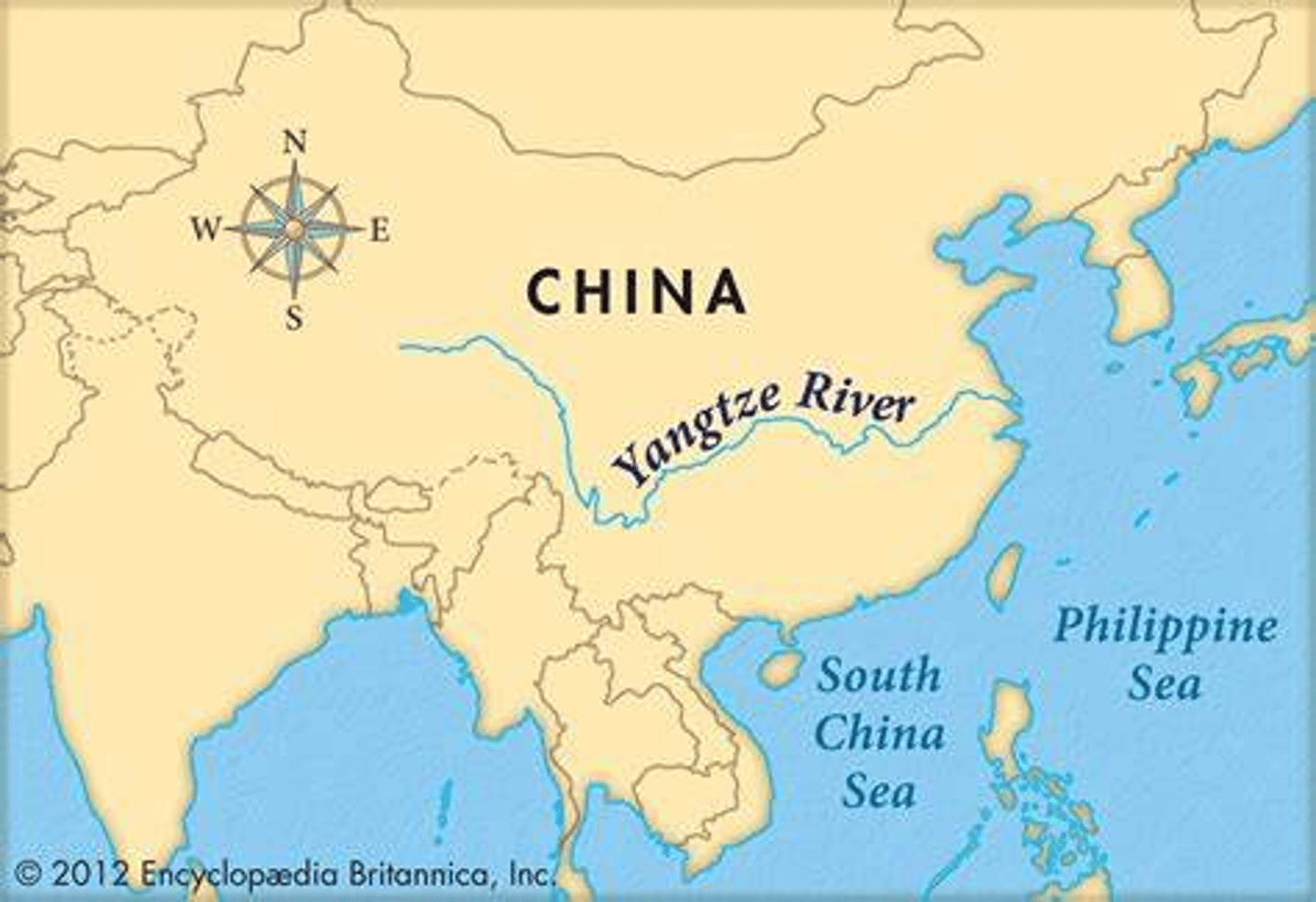
Chang'an
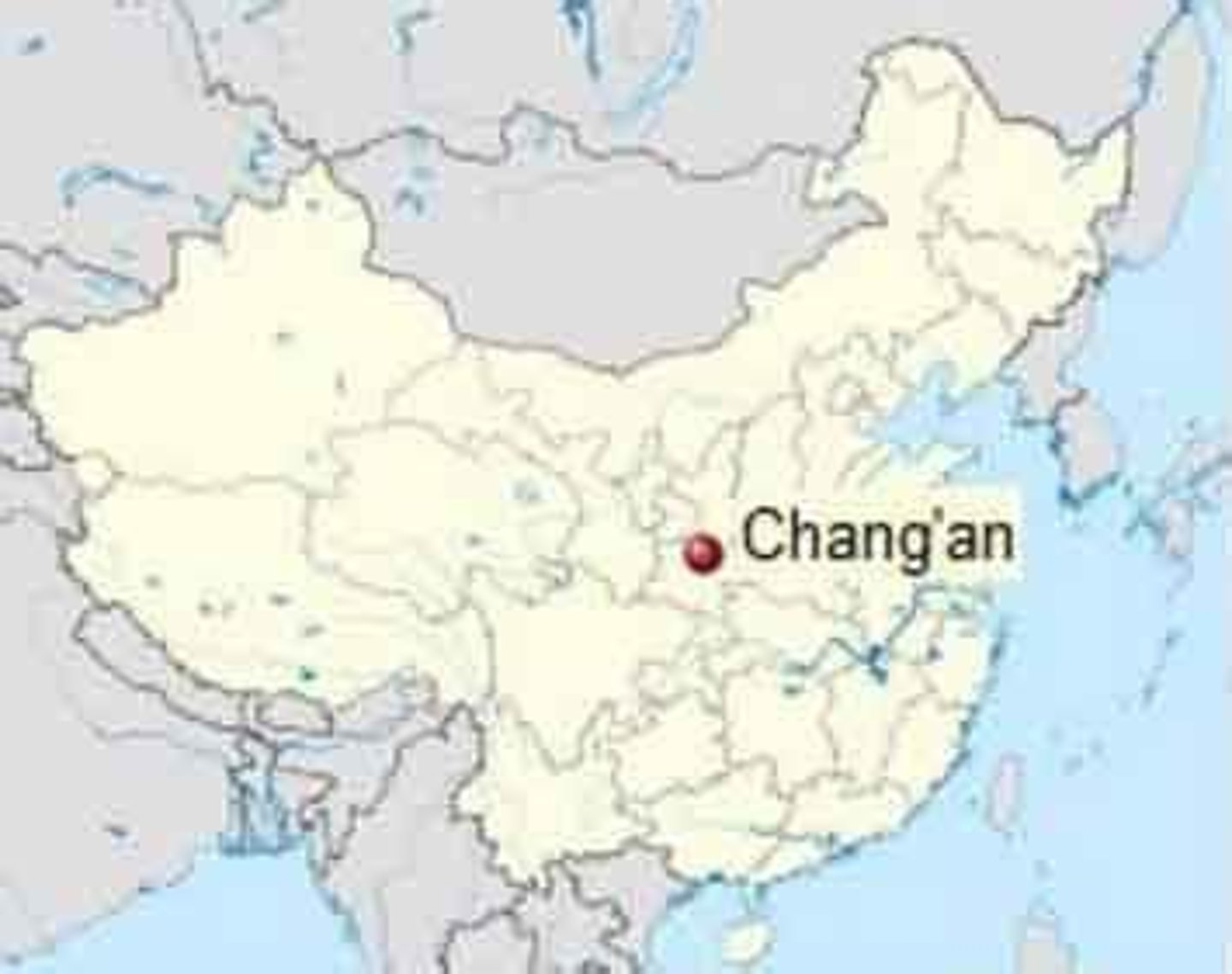
Alps (MAP)
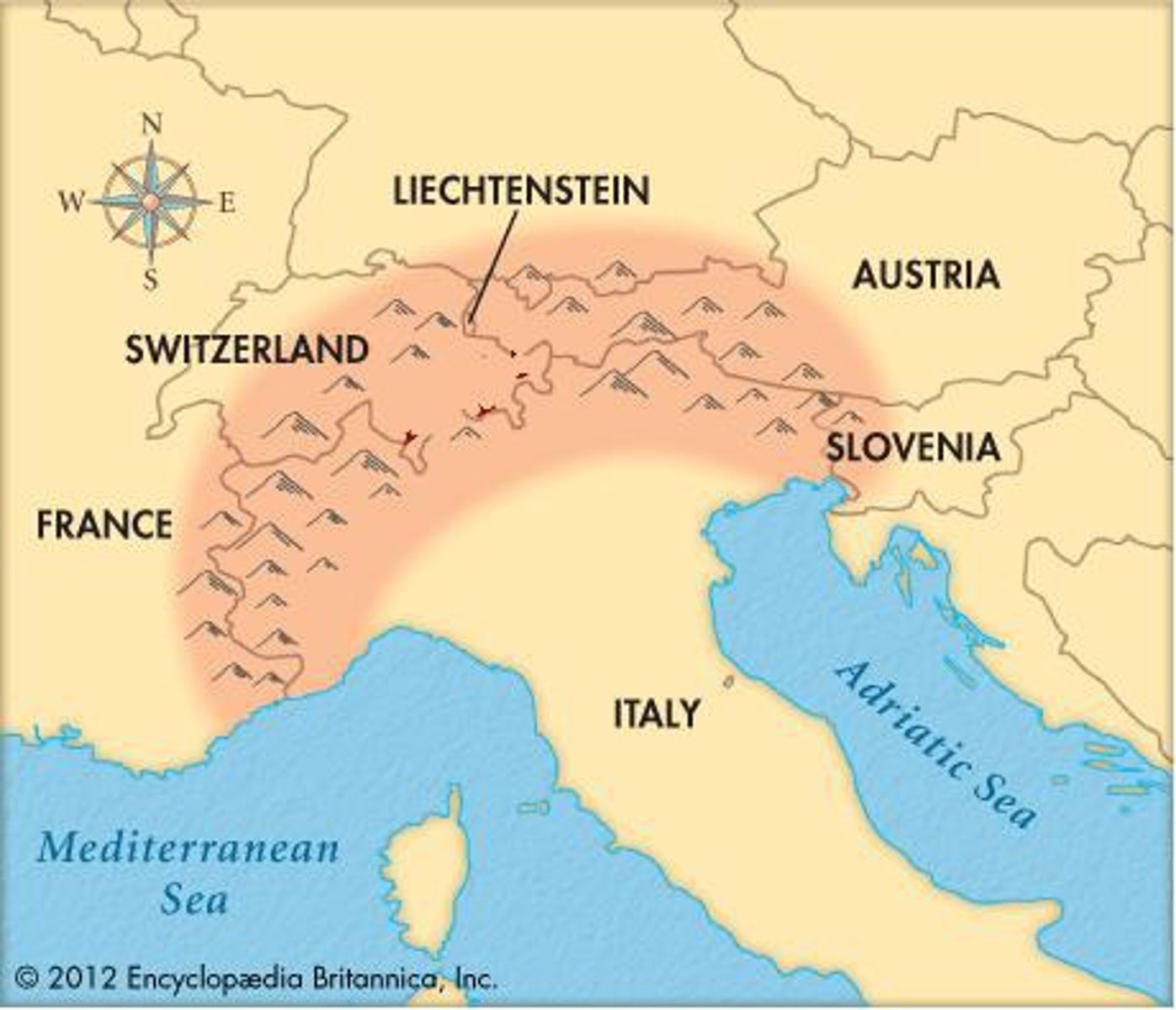
Himalayas (MAP)
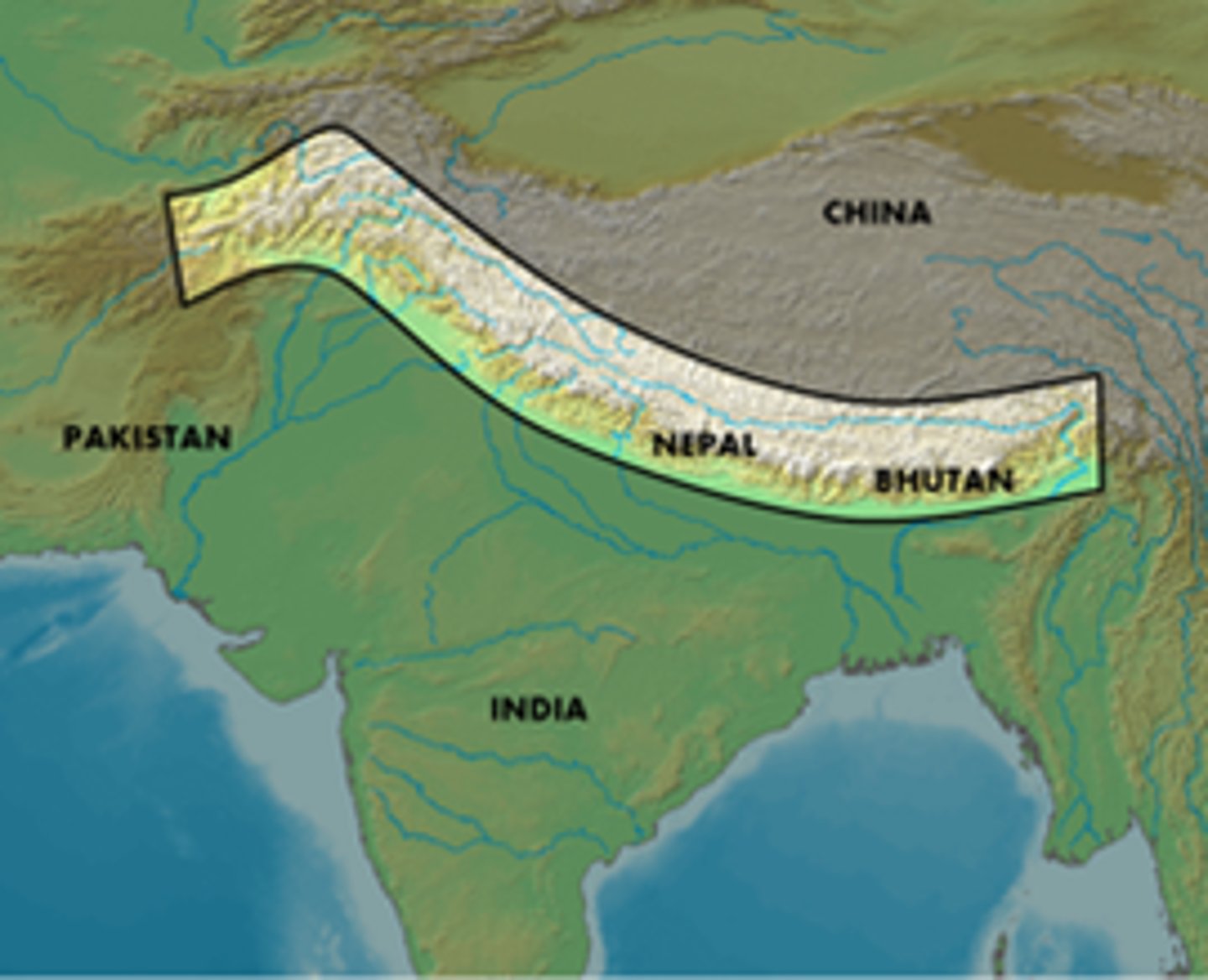
Hindu Kush (MAP)
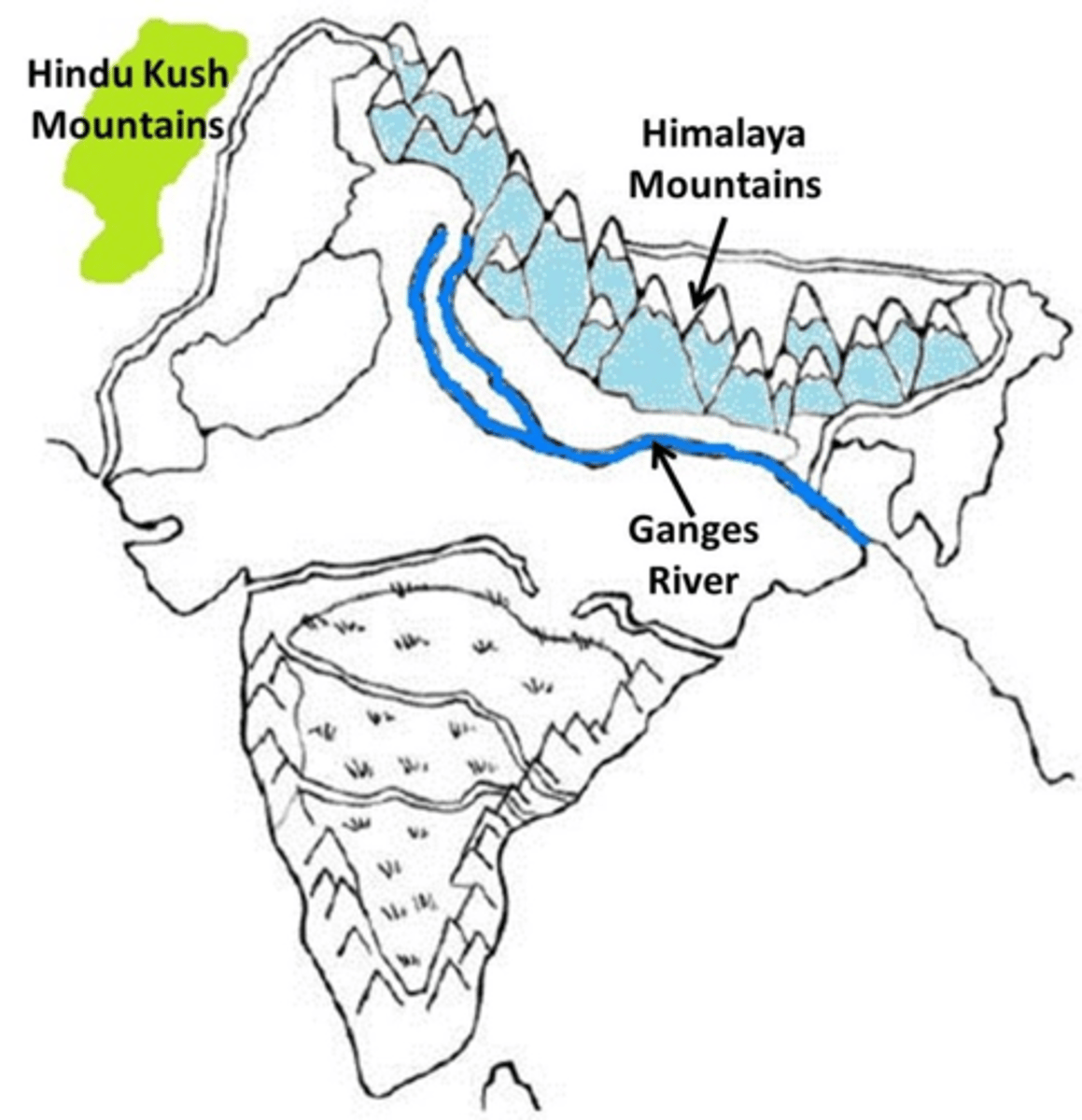
Taklamakan Desert (MAP)

Gobi Desert (MAP)
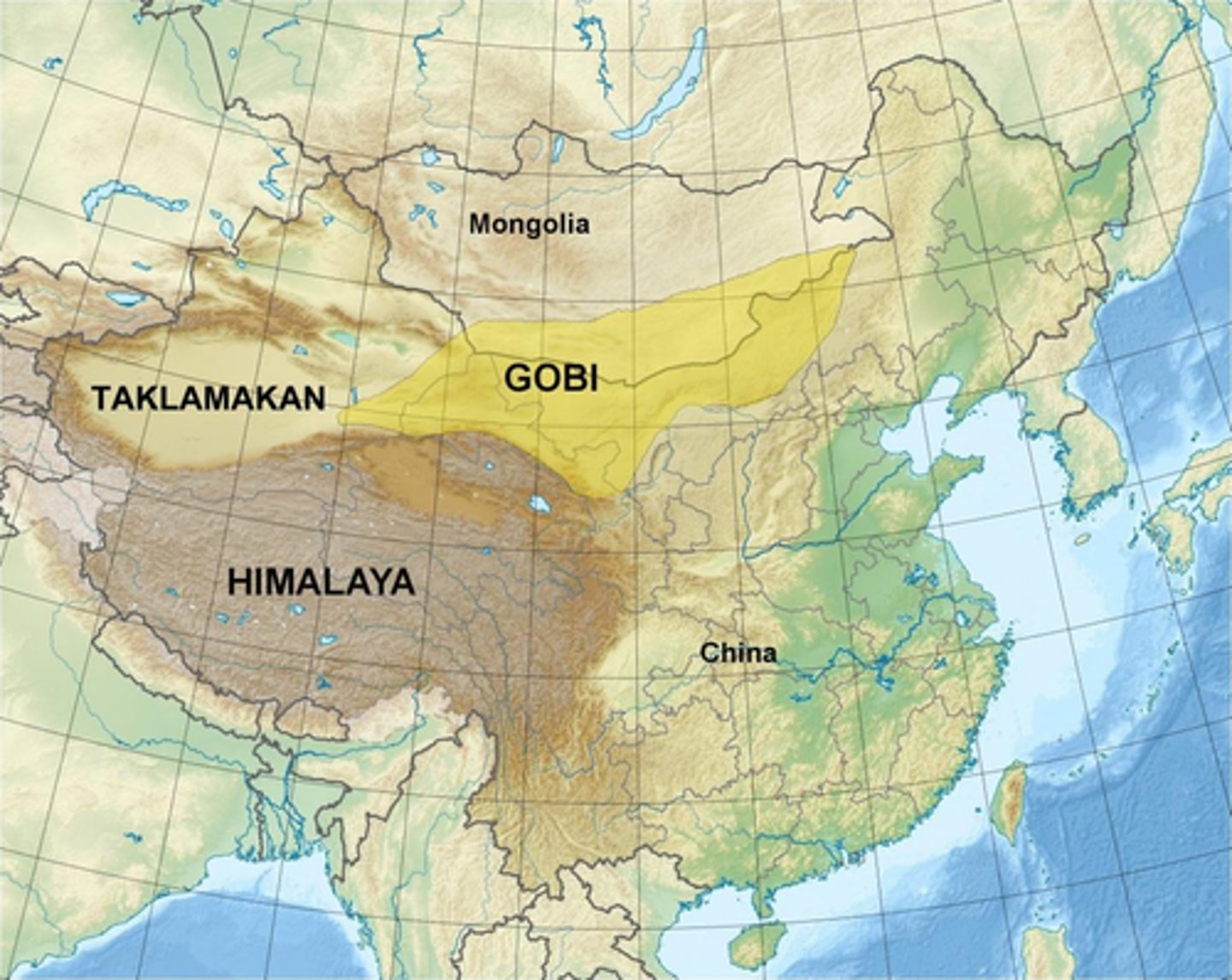
Yellow Sea (MAP)

Mesoamerica (MAP)

Gaul (MAP)
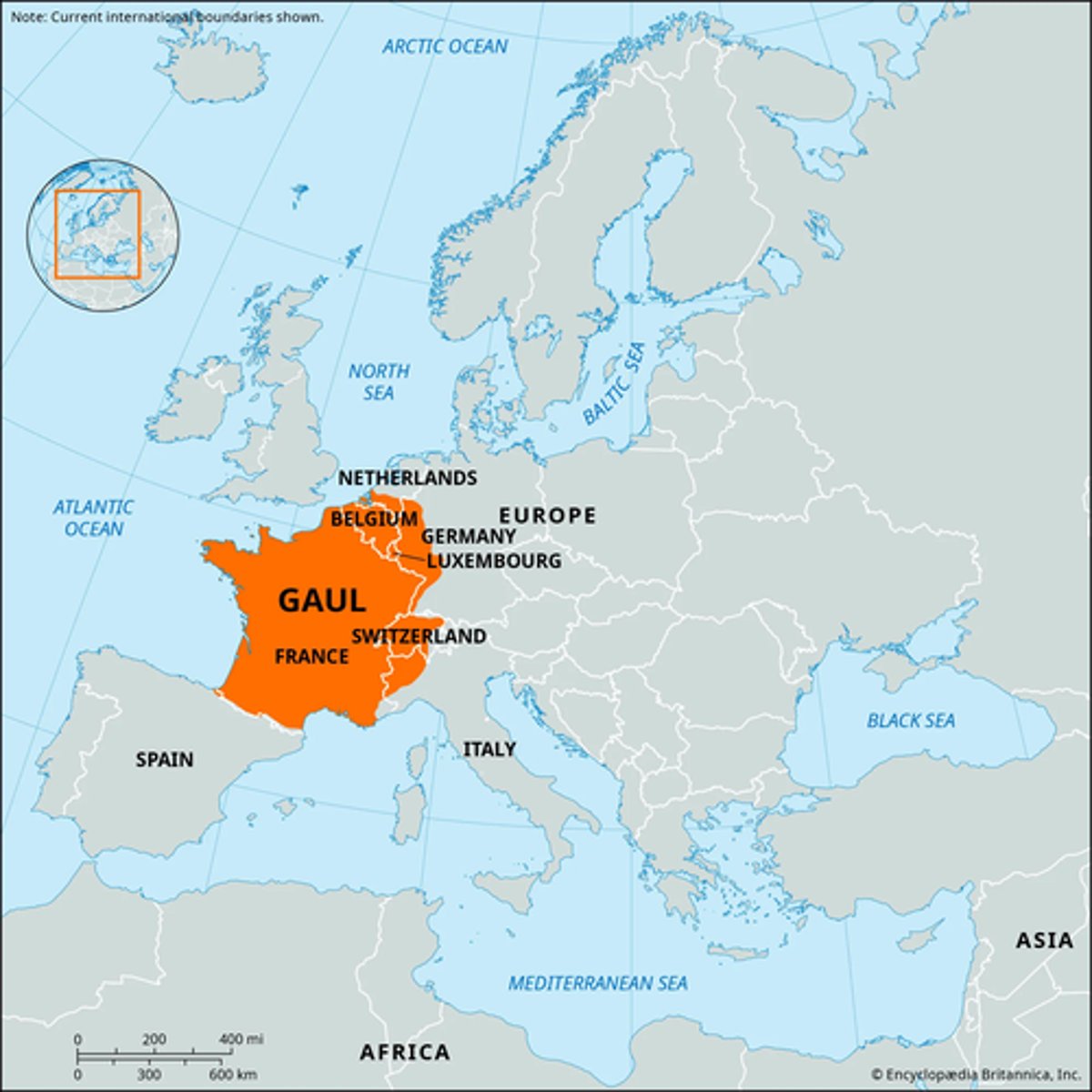
Silk Road (MAP)
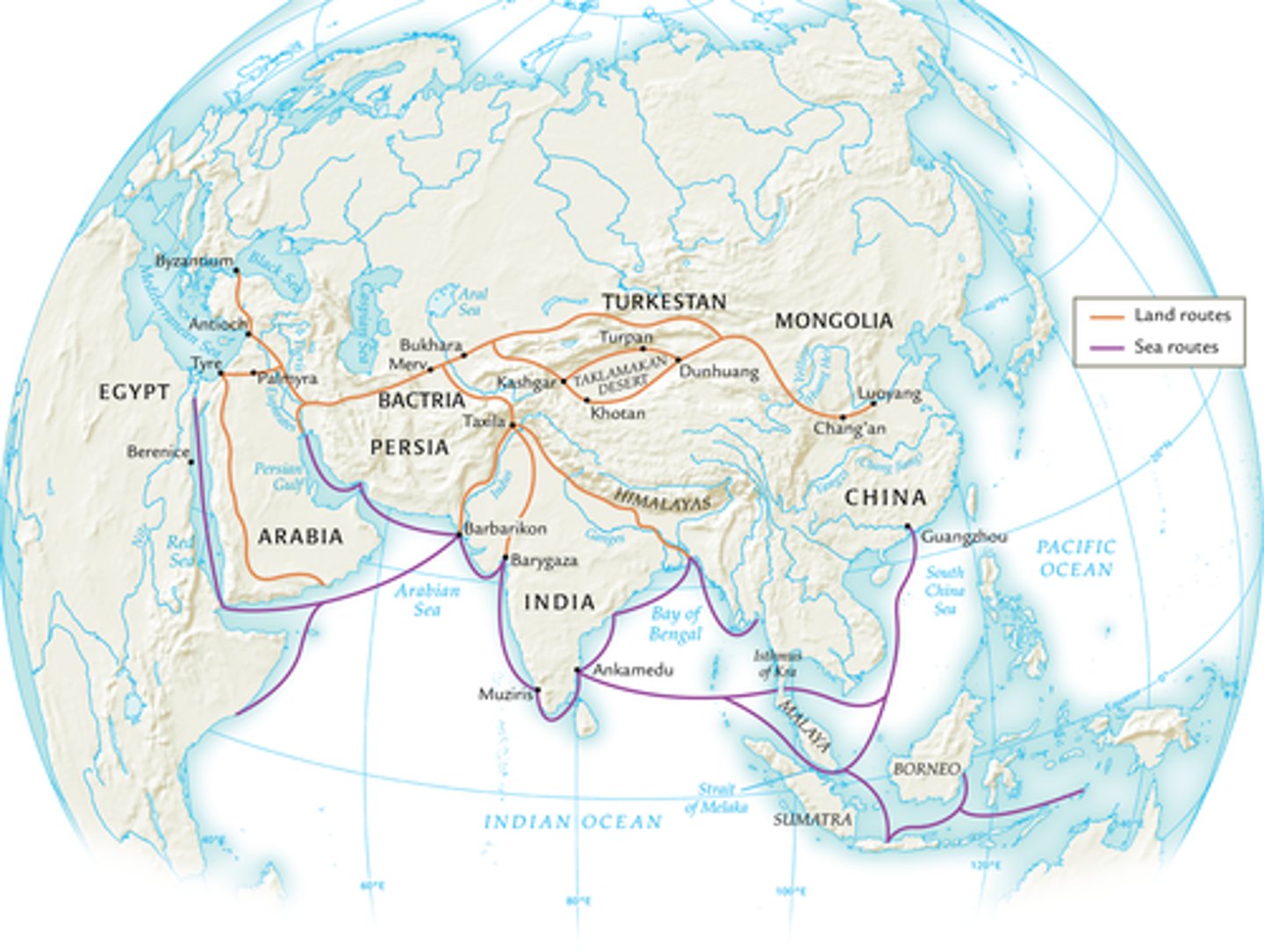
Maritime Trade Routes (MAP)
